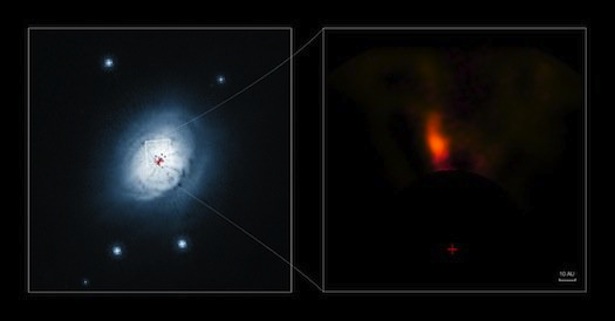Observations that have been made of a nearby star at infrared wavelengths have apparently detected the ongoing birth of a planet.
- Detail have been published in in the journal Astrophysical Letters
Within the above are two views of the gas and dust around star HD 100546, via PopSci. Left: a visible-light image from the Hubble Space Telescope. Right: an infrared image from the Very Large Telescope. In both, the red cross marks the location of the new protoplanet.
Astronomers were interested in the taking a good close look at this star because the disk of materials around it showed certain asymmetries. “It’s a good indication that something might be hiding or forming in the disk,” said Dr. Quanz (the team leader and astronomer at the Swiss university ETH Zurich), so the team he led made observations using a high-resolution infrared camera linked to a telescope located in Chile’s Atacama Desert.
The infrared imagery revealed a little bright blob in the disk, suggesting an entity emitting radiation. When the picture of the blob was laid over an image of the asymmetry, they coincided perfectly. The conclusion: The blob was an object embedded in the material around the star, suggesting a nascent planet.
How do Planets form?
Up until now we have simply guessed, the prevailing hypothesis is the nebular hypothesis: Dust grains circling around a parent star collide, the hypothesis goes, and develop into larger objects through a process of accretion.
This has remained a hypothesis because it has been incredibly hard to observe the phenomena, while we have already found a couple of other protoplanet examples that are a bit more developed, we haven’t actually been able to witness the actual birth of another planet so we take the evidence we have — the stuff we can observe — and reverse-engineer.
But this has just changed, because here now researchers have now apparently spotted a planet in the first pangs of its birth.
How exactly did they do this?
Using pictures captured by a high-resolution infrared camera — which was linked to the European Southern Observatory’s Very Large Telescope in Chile — the team observed what seems to be a planet in the midst of a disk of gas and dust that surrounds its central star, HD 100546 — a star located in the Milky Way, that is only 335 light years away from Earth (did I really just write ‘only’). Anyway, the protoplanet is about as massive as Jupiter, and, like Jupiter, is a gas giant.
This is also a very very young star, previous analyses of the its spectra suggest that HD 100546 is about 2.5 times the mass of our sun, and formed only a few million years ago. (There, I did it once again, I used the term “a few million years” to identify something as “young”, what can I say except welcome to cosmology, a field where the orders of magnitude make such usage meaningful).
The team believes the new planet is also so new that it could be the youngest we’ve ever observed. While there have been other probable protoplanets that have been contenders for “youngest planet” honors — objects discovered in 2011 and 2012, respectively — those bodies seem to be further ahead in their development than the one forming near HD 100546.
“They have already cleared a big gap in the disk of their host stars,”Quanz explains.
This finding could be one of the first direct observations of the earliest stages of a planet’s birth. But: (this is science, we need a “but”, that is what makes it honest) they still need to confirm that the data they have gathered actually suggest a forming planet.
What else might it be?
As all good scientists should do, they need to think through every possibility, and so another possible explanation for their observations, they note, is that the object in question is actually being ejected from its solar system, rather than being born into it. The data they have also suggests that HD 100546 has another planet orbiting closer to it, which could result in ejection for one of the two.
What next?
If there is a protoplanet out there, then they will have a long time to study it, because it would, the researchers note, take tens of thousands of years to mature from its current, infantile state.
Sascha Quanz, an astronomer at the Swiss university ETH Zurich and leader of the team, sums it up:
“If we are correct, this is the first time we are seeing a planet forming inside its natal environment.”
